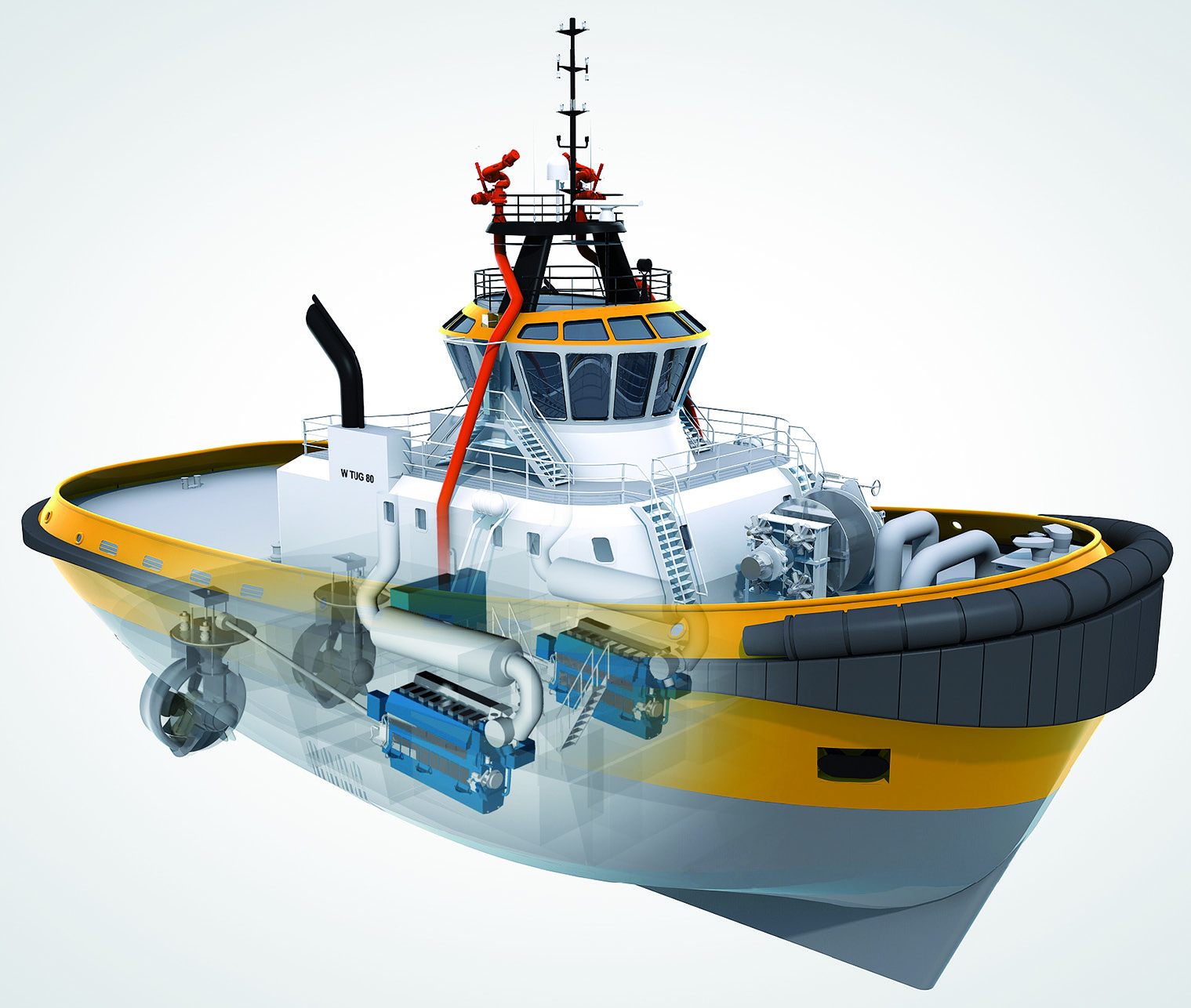

Tugs
Small vessels designed to tow or push large ships or barges. Tugs have powerful diesel engines and are essential to docks and ports to manoeuver large ships into their berths. Pusher tugs are also used to push trains of barges on the rivers and inland waterways. Oceangoing salvage tugs provide assistance to ships in distress and are engaged in such work as towing drilling rigs and oil production platforms.
The bollard pull is the leading requirement for tugs. There are two main tug types: those with their propulsion aft and towing point near amidships, i.e. conventional ones, or those with their towing point aft and propulsion forward of amidships, i.e. tractor tugs. Tugs with azimuthing propulsion, either Z-drive or cycloidal, have effectively displaced single or twin screw tugs.
- Azimuthing Stern Drive (ASD) tug, stern drive azimuth tug – The tug with two azimuth thrusters under the stern. ASD tugs perform the majority of towing operations over the bow, from a winch mounted on the fore deck.
- Carousel tug – New type of tug provided with the carousel system, which enables the towing point to be changed according to the direction of the tow. This greatly reduces the capsizing moment. It is even claimed that it is not possible to capsize a carousel tug. The system uses a circular ring attached around the base of the superstructure on the tug. This consists of two parts: the fixed inner ring and the rotating outer ring. A simple towing hook is mounted on the outer ring as the attachment point for the towline.
Novatug’s Carrousel system increases the effectiveness and lowers the cost of harbour and escort tugs. It works by placing a ring around the tug’s superstructure that rotates freely, with the towing wire connected to the ring by a hook or winch, allowing the towing wire to rotate freely from the tug’s hull. This leaves no need for rotation of the tug’s propulsion by means of expensive, complex and high-maintenance thrusters.
The Carrousel system enables the towing wire to rotate 360 degrees around the tug. The prototype of the Carrousel tug, ´Multratug 12`, has executed numerous harbour towage assistances during a test period. The results show that breaking and steering powers can be multiplied by a factor of five, whilst safety remains guaranteed. At the same time operating costs (fuel, maintenance, surveys and damages) are substantially decreased.
- Escort tug – A novel fast type tug designed to assist tankers in areas of high environmental risk. Escort tugs run with tankers at speeds of up to 14 knots to provide an emergency steering and breaking force capability.
- Forward azimuth tractor – The tug with two azimuth thrusters under the forebody.
- Rotor tug – A new patented concept in the tug design with a unique propulsion system utilising three main engines, each driving a fully azimuthing propulsion unit. Two propulsion units are located forward off the centreline, in the normal tractor configuration, with the third unit aft off the centreline replacing traditional aft skeg. The tug has the ability to turn rapidly in its own length, and apply almost all of its bollard pull in any direction. The lack of a substantial skeg reduces resistance to turning and cuts down the influence of a ship propeller wash when working in close proximity to large vessels underway. Astilleros Balenciaga delivered the first pair of Rotor tugs – RT Innovation and RT Pioneer in 1999.
- Salvage tug – A tug having specific equipment for salvage.
- Standby tug – A vessel which is stationed at a specific location with the primary purpose of preventing a ship in trouble becoming a major casualty with the risk of pollution. Alternatively, where an accident has already happened to provide salvage and clean up facilities as quickly as possible to prevent the situation becoming worse.
- Tractor tug, originally Water Tractor – The unique tug concept developed by Voith-Schneider for the use with cycloidal propellers. A classic tractor tug has some characteristic features, such as:
1. Propulsion and steering system freely arranged underneath the hull at one end of the vessel.
2. A keel plate underneath the freely-arranged propulsion and steering device protecting the units against grounding and obstacles in all directions.
3. Rudder-shaped fin underneath the hull, opposite to the propulsion and steering devices.
4. The towing gear above the fin.
